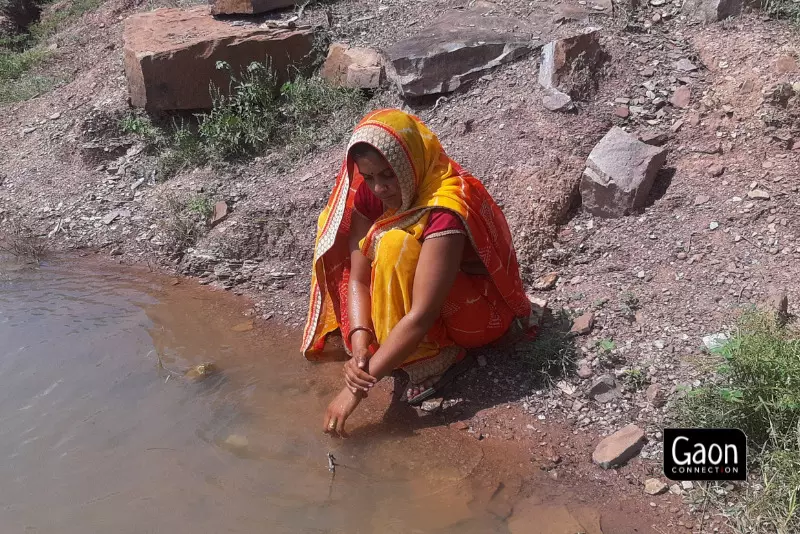Gironiya (Dholpur), Rajasthan
After the withdrawal of the monsoon, when millions of farmers across India prepare to sow their rabi crops of wheat and mustard, Seema Devi had to leave her four acres of land in Gironiya village, uncultivated.
Like her, the 30 odd families living in the severely water-strapped village in Dholpur district, about 270 kms away from Jaipur the state capital of Rajasthan, depended entirely on the monsoon rainfall to cultivate some bajra and tilhan (pearl millet and oilseeds) for a few months of the year.
For the rest of the time the lands lay barren. The villagers had to buy wheat and other essentials for their food from outside.
Last year Seema Devi’s joy knew no bounds when for the first time she harvested thousands of kilogrammes (kg) of wheat and mustard from her land. “For the first time we got 32 quintals of wheat and 24 quintals of mustard from our four acres of land [1 quintal = 100 kgs]. My extended family of 30 members spent about a lakh of rupees annually to buy wheat from the market. Now we are saved from that expenditure,” Seema Devi told Gaon Connection.

Rain water is being harvested in ponds and used for cultivating rabi crops in the winter season.
According to her, before 2020, her land yielded only about four quintals of mustard. But now the farm produce has multiplied manifold and the farmer households are also able to cultivate the rabi crop of wheat, a first in the Gironiya village.
The credit for this transformation goes to a state government scheme called Paramparagat Varsha Jal Sanchayan (Traditional Rain Water Conservation), which was launched in this village in December 2020.
Neelam Kushwaha, panchayat secretary in Sarmathura block in Dholpur said that the government has started the water conservation project to increase moisture level in the soil and ensure irrigation facility to farmers. Rain water is being harvested in ponds and used for cultivating rabi crops in the winter season, she added.
“Dholpur district has the highest barren land in Rajasthan. Altogether 23.83 lakh hectare [2.383 million hectares] land is barren and uncultivable in the state. Through Paramparagat Varsha Jal Sanchayan the government is trying to provide irrigation facilities to farmers for better productivity”, the panchayat secretary added.
When farmers offered their land to capture the rainwater
Under the Paramparagat Varsha Jal Sanchayan scheme, which has been jointly implemented in Gironiya village by the state government and Manjari Foundation, a non-profit, farmers were involved in creating water harvesting structures and made stakeholders in the project.
“Thirteen pokhar [ponds] were dug in the village to harvest the rainwater. This helped the 30 families living there to get water for irrigation and other purposes, ” Rammurti Meena, field coordinator of Manjari Foundation, told Gaon Connection. Manjari Foundation worked with the people and promoted water harvesting and plantation in Gironiya.
The scheme was taken forward with the active participation of the villagers, many of whom gave land (as beneficiary of the water scheme) to build the ponds. About 40 acres of cultivable land in the village is benefitting from this water harvesting scheme, Meena said.
Also Read: One sack of fertiliser per Aadhaar; farmers in UP’s Unnao complain it is not enough

Promotion of water preservation at Gironiya village of Dholpur.
According to the field coordinator, several farmers provided the land to build ponds and contributed 25 per cent of the cost of constructing the ponds while the HDFC bank paid the remaining 75 per cent. “The ponds were ready by April 2021, and in the monsoon they were all filled to the brim,” Meena added.
Farmers cultivate wheat for the first time
Seema Devi’s family was one of those who gave 1.32 acres of land for the building of the pond, and paid Rs 35,000 to do so. The remaining Rs 150,000 was paid for by the state government.
Mahesh Singh Jadon offered 0.66 acre of land and Rs 25,000 for the construction of the pond. The balance amount of Rs 75,000 was given by the HDFC bank. “For the first time I am cultivating wheat on my land that lay barren otherwise. I cannot wait to harvest my first wheat crop this rabi season,” Jadon told Gaon Connection.
Similarly, Asha Devi allowed 2.31 acres of her land to be converted into a pond. She gave Rs 75,000 for its construction while the HDFC bank spent Rs 300,000 for it. “My land was hard and it required more effort to dig it out for making the pond,” Asha Devi told Gaon Connection.

Thirteen pokhar were dug in the village to harvest the rainwater.
“Last year I grew mustard in six and a half acres of land. I spent Rs 25, 000 on the land and made an earning of Rs 1.20 lakh [Rs 120,000]. I hope to double that income,” she said. She said the pond would ensure enough water for mustard cultivation and get her that profit.
The farmers who gave their land to build ponds shared the water with other farmers who in turn paid for the diesel/electricity to run the water pumps.
Before this water harvesting scheme was implemented in the village, it was common practice for the villagers to use camels to fetch water from the Damoh waterfall a kilometre away, twice a day. Each camel carried 120 litres of water just enough for the needs of one family.
While the state government began supplying water under the Jal Swavlamban Yojna, through a pipeline in January 2016, it was meant for drinking purposes only. There was no water for other uses such as bathing, irrigation and for their animals.
The villagers now not only grow their own wheat and mustard, thanks to adequate water for irrigation, they also have enough water for their livestock and use the husks of grain as fodder for them.


















